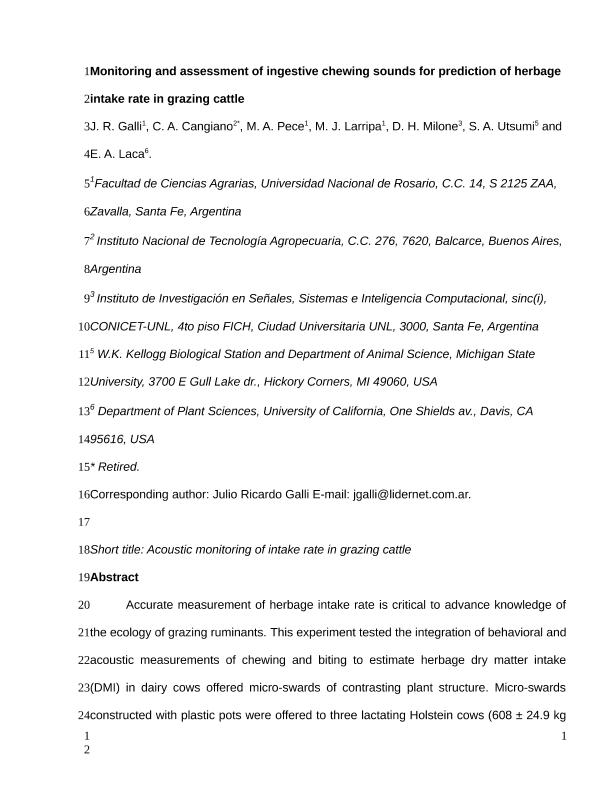Artículo
Monitoring and assessment of ingestive chewing sounds for prediction of herbage intake rate in grazing cattle
Galli, Julio Ricardo; Cangiano, Carlos Alberto; Pece, M. A.; Larripa, M. J.; Milone, Diego Humberto ; Utsumi, S. A.; Laca, E. A.
; Utsumi, S. A.; Laca, E. A.
 ; Utsumi, S. A.; Laca, E. A.
; Utsumi, S. A.; Laca, E. A.
Fecha de publicación:
10/2017
Editorial:
Cambridge University Press
Revista:
Animal
ISSN:
1751-7311
Idioma:
Inglés
Tipo de recurso:
Artículo publicado
Clasificación temática:
Resumen
Accurate measurement of herbage intake rate is critical to advance knowledge of the ecology of grazing ruminants. This experiment tested the integration of behavioral and acoustic measurements of chewing and biting to estimate herbage dry matter intake (DMI) in dairy cows offered micro-swards of contrasting plant structure. Micro-swards constructed with plastic pots were offered to three lactating Holstein cows (608±24.9 kg of BW) in individual grazing sessions (n=48). Treatments were a factorial combination of two forage species (alfalfa and fescue) and two plant heights (tall=25±3.8 cm and short=12±1.9 cm) and were offered on a gradient of increasing herbage mass (10 to 30 pots) and number of bites (~10 to 40 bites). During each grazing session, sounds of biting and chewing were recorded with a wireless microphone placed on the cows? foreheads and a digital video camera to allow synchronized audio and video recordings. Dry matter intake rate was higher in tall alfalfa than in the other three treatments (32±1.6 v. 19±1.2 g/min). A high proportion of jaw movements in every grazing session (23 to 36%) were compound jaw movements (chew-bites) that appeared to be a key component of chewing and biting efficiency and of the ability of cows to regulate intake rate. Dry matter intake was accurately predicted based on easily observable behavioral and acoustic variables. Chewing sound energy measured as energy flux density (EFD) was linearly related to DMI, with 74% of EFD variation explained by DMI. Total chewing EFD, number of chew-bites and plant height (tall v. short) were the most important predictors of DMI. The best model explained 91% of the variation in DMI with a coefficient of variation of 17%. Ingestive sounds integrate valuable information to remotely monitor feeding behavior and predict DMI in grazing cows.
Palabras clave:
Acoustic Analysis
,
Chew-Bite
,
Chewing
,
Ingestive Behavior
,
Ruminants
Archivos asociados
Licencia
Identificadores
Colecciones
Articulos(SINC(I))
Articulos de INST. DE INVESTIGACION EN SEÑALES, SISTEMAS E INTELIGENCIA COMPUTACIONAL
Articulos de INST. DE INVESTIGACION EN SEÑALES, SISTEMAS E INTELIGENCIA COMPUTACIONAL
Citación
Galli, Julio Ricardo; Cangiano, Carlos Alberto; Pece, M. A.; Larripa, M. J.; Milone, Diego Humberto; et al.; Monitoring and assessment of ingestive chewing sounds for prediction of herbage intake rate in grazing cattle; Cambridge University Press; Animal; 12; 5; 10-2017; 973-982
Compartir
Altmétricas



